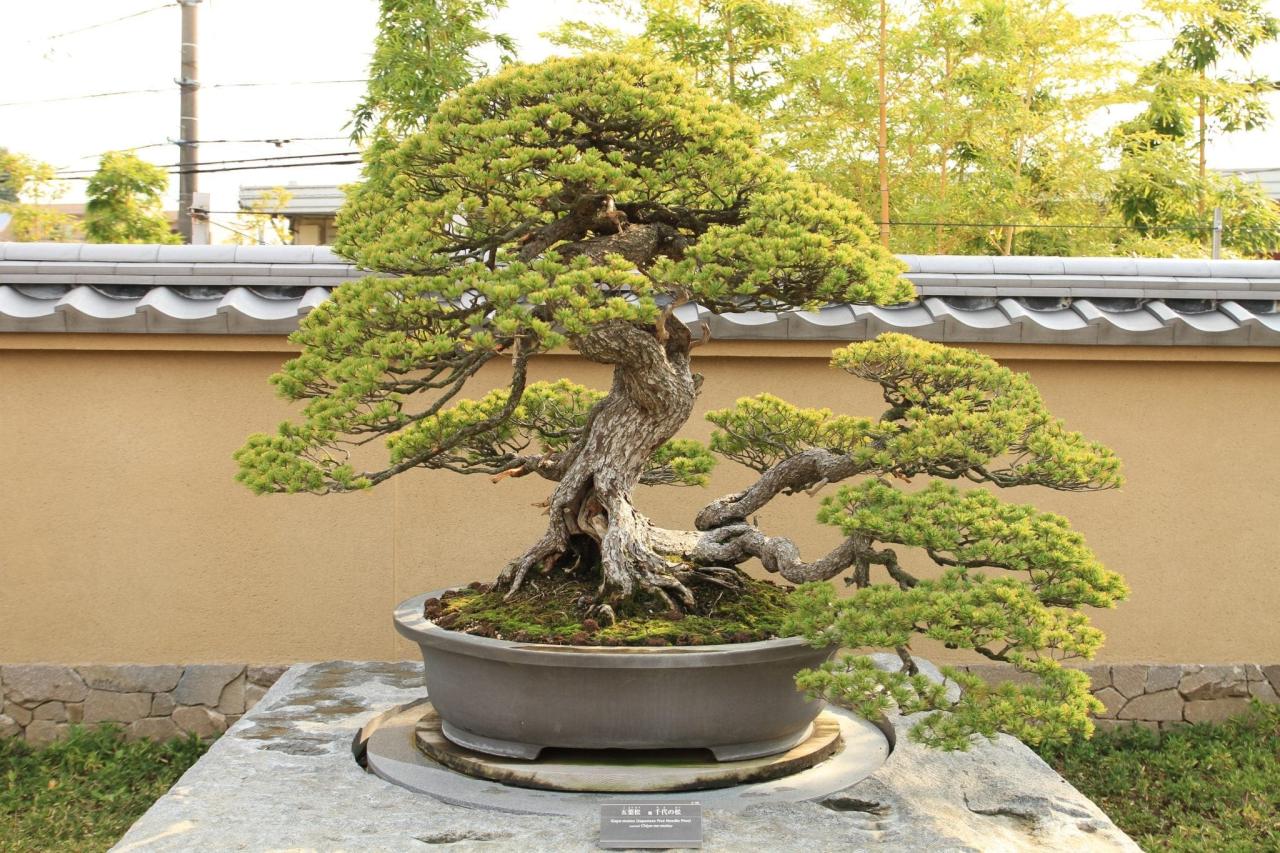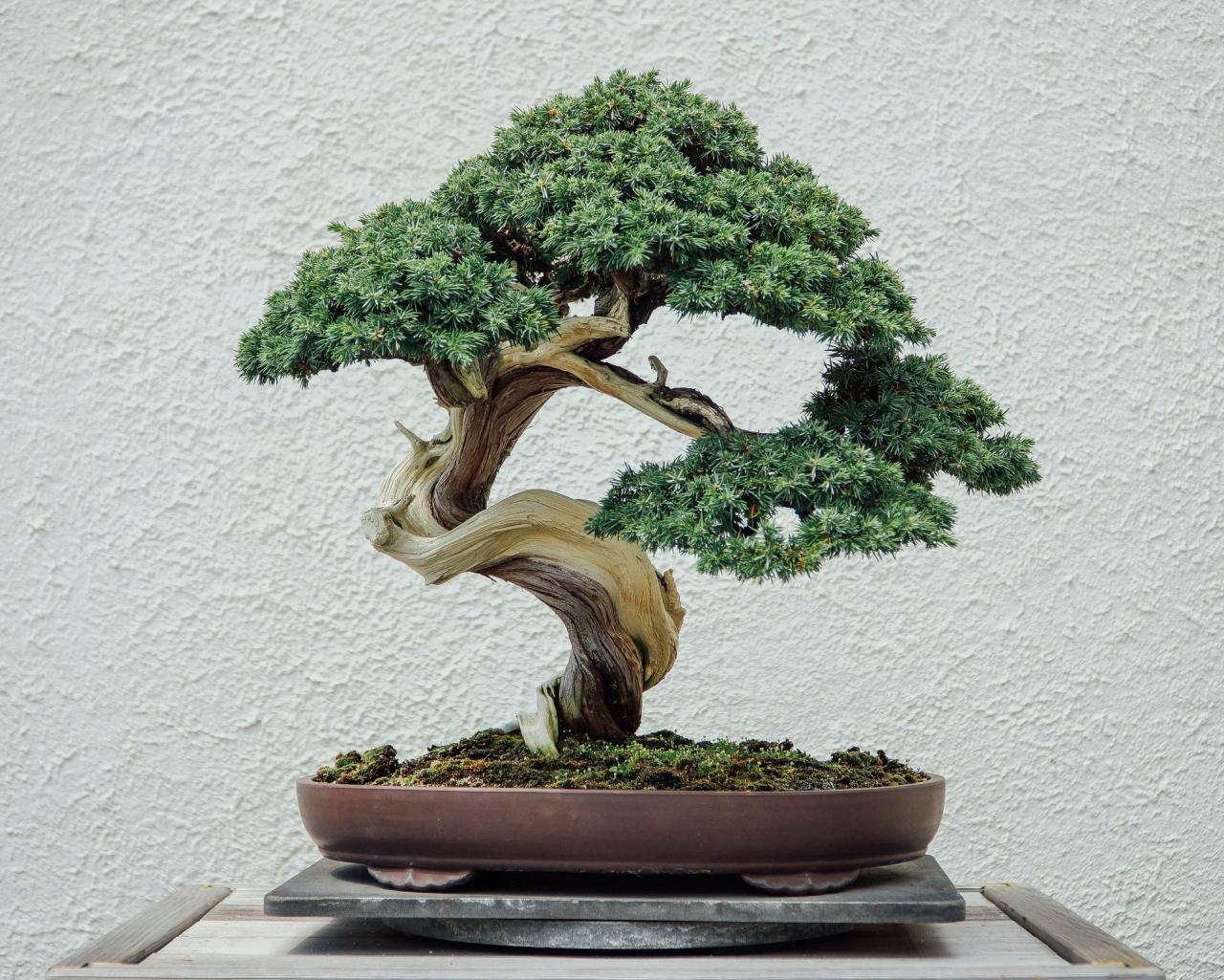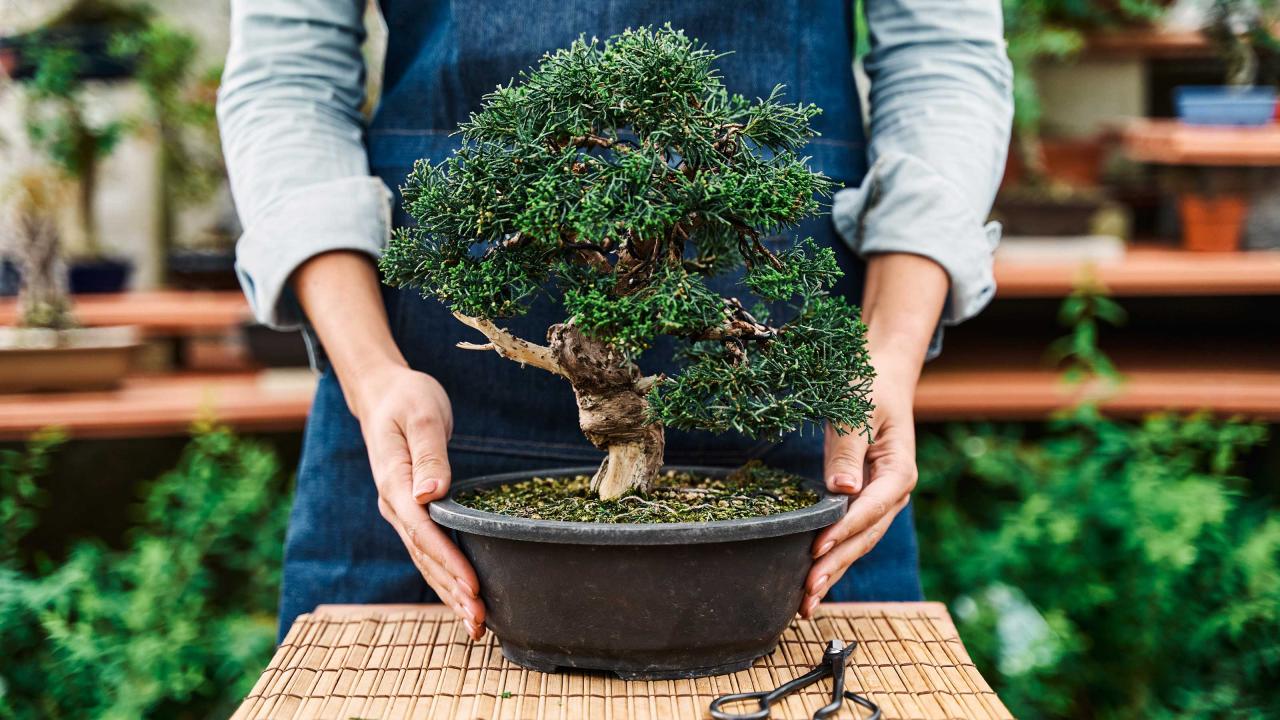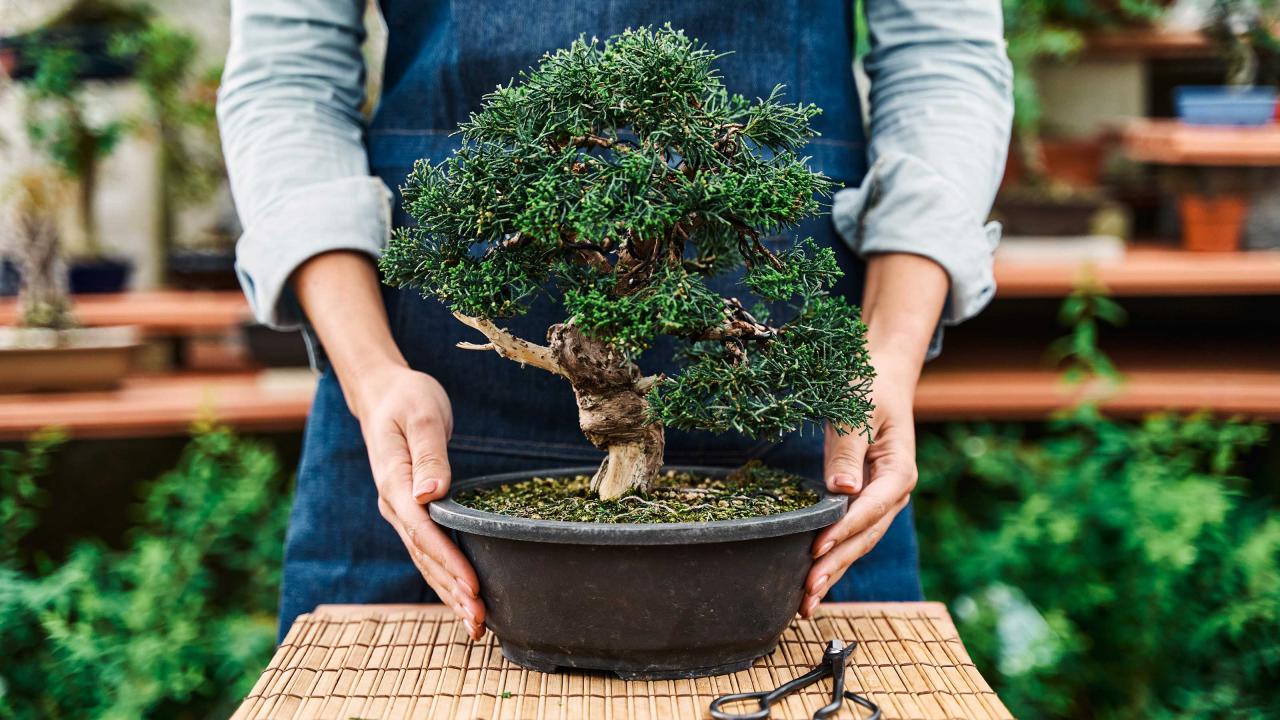How to Care for Bonsai Trees: Essential Do’s and Don’ts sets the stage for this enthralling narrative, offering readers a glimpse into a story that is rich in detail and brimming with originality from the outset. Bonsai, the art of cultivating miniature trees in containers, has captivated enthusiasts for centuries.
Its roots trace back to ancient China and Japan, where bonsai held profound cultural and spiritual significance. Today, this fascinating practice continues to thrive, offering a rewarding journey into the world of miniature horticulture. This guide delves into the fundamental aspects of bonsai care, providing a comprehensive understanding of the essential do’s and don’ts that ensure the health and longevity of your bonsai trees.
Introduction to Bonsai Trees
Bonsai, a Japanese art form that involves cultivating miniature trees in containers, has captivated people worldwide for centuries. These living works of art are not merely small trees but symbolize nature’s resilience and beauty, offering a unique connection between humans and the natural world.
History and Origin
The art of bonsai has its roots in ancient China, where miniature trees were cultivated for their aesthetic appeal and symbolic value. The practice of “penjing,” meaning “tray landscape,” dates back to the 6th century AD, with the earliest documented examples found in Tang dynasty poetry and paintings.
During the 12th century, Zen Buddhism, with its emphasis on meditation and contemplation, influenced the development of bonsai in Japan. The Japanese refined the techniques and aesthetics of bonsai, incorporating elements of traditional Japanese gardens and philosophy. By the 17th century, bonsai had become a popular art form among the Japanese aristocracy, and it continues to be cherished as a cultural treasure.
Cultural Significance
Bonsai holds deep cultural significance in various parts of the world. In Japan, bonsai is considered a living embodiment of nature’s harmony and the passage of time. It represents patience, perseverance, and the interconnectedness of all living things. The art of bonsai is often practiced as a meditative and therapeutic activity, allowing individuals to connect with nature and find inner peace.In China, bonsai, known as “penjing,” is associated with longevity, prosperity, and good fortune.
It is often displayed in homes and gardens, symbolizing the owner’s appreciation for nature and their commitment to cultivating beauty and harmony.In the West, bonsai has gained popularity as a unique and challenging art form. It is admired for its aesthetic beauty, the skill involved in its cultivation, and the opportunity to create miniature landscapes that evoke a sense of wonder and tranquility.
Bonsai Tree Species, How to Care for Bonsai Trees: Essential Do’s and Don’ts
Bonsai trees can be cultivated from a wide variety of species, each with its own unique characteristics and aesthetic appeal. Some popular bonsai species include:
- Japanese Black Pine (Pinus thunbergii):Known for its dark green needles, strong branches, and ability to withstand harsh conditions.
- Japanese Red Pine (Pinus densiflora):Characterized by its reddish-brown bark, soft needles, and graceful growth habit.
- Juniper (Juniperus spp.):Hardy and adaptable, junipers offer a wide range of shapes and textures, from upright to cascading forms.
- Maple (Acer spp.):Renowned for their vibrant fall foliage, maples are popular bonsai choices for their delicate leaves and intricate branching patterns.
- Ficus (Ficus spp.):Fast-growing and adaptable, ficus trees are well-suited for beginners and offer a variety of leaf shapes and sizes.
The choice of bonsai species depends on the individual’s preferences, the climate, and the desired aesthetic.
Bonsai Styles and Design: How To Care For Bonsai Trees: Essential Do’s And Don’ts

Bonsai styles are a fundamental aspect of bonsai art, representing a vast array of artistic expressions. These styles go beyond mere aesthetics; they embody the natural beauty of trees, reflecting their growth patterns and characteristics in miniature form. Understanding these styles is crucial for both appreciating and creating bonsai.
Bonsai Styles
Bonsai styles are categorized based on their visual appearance and the way they are trained. Each style has specific characteristics and guidelines, creating a diverse and captivating spectrum of bonsai forms.
- Formal Upright (Chokkan):The most classic and symmetrical style, featuring a straight trunk with a tapered crown. The branches are evenly spaced, with the lowest branch being the thickest, gradually decreasing in size towards the apex.
Example:A Japanese Black Pine (Pinus thunbergii) trained in this style showcases its natural elegance and symmetry.
- Informal Upright (Moyogi):A more natural and flowing style with a slightly curved trunk that leans slightly to one side. The branches are arranged in a staggered pattern, adding dynamism and asymmetry to the composition.
Example:A Chinese Elm (Ulmus parvifolia) trained in this style exhibits a graceful and organic appearance.
- Slanting (Shakan):A dramatic style featuring a trunk that leans significantly to one side. The branches are typically positioned on the opposite side of the lean, creating a sense of tension and balance.
Example:A Japanese Red Maple (Acer palmatum) trained in this style showcases a striking and dynamic presence.
- Cascade (Kengai):A style where the trunk cascades downwards, mimicking a tree growing on a cliff face. The branches extend beyond the pot, creating a waterfall-like effect.
Example:A Japanese Black Pine (Pinus thunbergii) trained in this style demonstrates a powerful and dramatic presence.
- Semi-cascade (Han-kengai):Similar to the Cascade style but with the trunk cascading less dramatically. The apex of the tree remains above the rim of the pot.
Example:A Japanese White Pine (Pinus parviflora) trained in this style showcases a graceful and flowing form.
- Broom (Hokidachi):A style where the branches radiate from a single point on the trunk, resembling a broom. This style is typically seen in deciduous trees.
Example:A Japanese Maple (Acer palmatum) trained in this style exhibits a unique and delicate appearance.
- Literati (Bunjingi):A style that emphasizes elegance and refinement, featuring a slender trunk with a few branches that are placed strategically to create a sense of movement and grace.
Example:A Chinese Juniper (Juniperus chinensis) trained in this style showcases a sophisticated and artistic presence.
- Windswept (Fukinagashi):A style that mimics trees exposed to strong winds, featuring a trunk that leans in one direction and branches that bend in the opposite direction.
Example:A Japanese Black Pine (Pinus thunbergii) trained in this style exhibits a rugged and dynamic appearance.
- Twin-trunk (Sokan):A style featuring two trunks that emerge from a single root system. The trunks can be of equal or different sizes and can be positioned parallel or slightly offset.
Example:A Japanese Black Pine (Pinus thunbergii) trained in this style showcases a harmonious and balanced composition.
- Group Planting (Yose-ue):A style that features multiple trees planted together in a single pot, creating a miniature forest scene. The trees are typically of different species and sizes, adding visual interest and depth.
Example:A group planting of Japanese Black Pine (Pinus thunbergii) and Japanese Red Maple (Acer palmatum) showcases a dynamic and natural scene.
Wiring in Bonsai Design
Wiring is a crucial technique in bonsai design, allowing for the manipulation of branches and trunks to achieve the desired shape and style.
- Purpose of Wiring:Wiring is used to bend and position branches, creating curves and angles that mimic the natural growth patterns of trees. It also helps to control the growth direction of branches and maintain the desired style.
- Types of Wire:Aluminum wire is commonly used for bonsai due to its flexibility and durability. Copper wire is also used, but it is more rigid and can damage the bark if not used carefully.
- Techniques:Wiring involves wrapping the wire around branches and trunks to apply pressure and guide their growth. The wire is typically removed after the branch has set in its new position, although it may be left on for several years in some cases.
- Timing:Wiring is best done during the tree’s dormant season, typically in late fall or winter, when the branches are less flexible and less likely to be damaged.
Tools for Bonsai Design and Maintenance
Having the right tools is essential for creating and maintaining bonsai trees.
- Pruning Shears:Used for removing unwanted branches and shaping the tree. They come in various sizes and shapes to suit different tasks.
Example:Concave cutters are ideal for removing thick branches, while bypass pruners are suitable for smaller branches.
- Wire Cutters:Used for cutting wire when it is no longer needed. They should be sharp and strong enough to cut through aluminum and copper wire.
Example:Flush cutters are ideal for cutting wire close to the branch, while diagonal cutters are useful for cutting wire at an angle.
- Bonsai Scissors:Similar to pruning shears but with a smaller blade, designed for fine pruning and shaping.
Example:Bonsai scissors with curved blades are ideal for shaping branches and creating curves, while straight-bladed scissors are useful for trimming foliage.
- Bonsai Tweezers:Used for removing unwanted buds and leaves, as well as for adjusting the position of small branches.
Example:Long-nosed tweezers are ideal for reaching into tight spaces, while straight tweezers are useful for general manipulation.
- Bonsai Pots:Designed specifically for bonsai trees, they come in various shapes, sizes, and materials. The pot should be chosen to complement the style and size of the tree.
Example:Shallow pots are ideal for trees with shallow root systems, while deep pots are suitable for trees with deep root systems.
Troubleshooting Common Bonsai Problems
Bonsai trees, like any other living organism, are susceptible to various problems. Recognizing these problems early and addressing them promptly is crucial for maintaining the health and vitality of your bonsai. This section delves into common bonsai problems, their causes, and effective solutions.
Leaf Drop
Leaf drop in bonsai trees can be a sign of stress or disease. Several factors can contribute to this problem.
- Incorrect Watering:Overwatering or underwatering can cause leaf drop. Overwatering leads to root rot, while underwatering causes dehydration.
- Environmental Stress:Sudden changes in temperature, humidity, or light exposure can shock the tree and trigger leaf drop.
- Pests and Diseases:Pests like aphids, spider mites, and scale insects can damage leaves, leading to leaf drop. Fungal diseases can also cause leaf discoloration and shedding.
- Nutrient Deficiency:Lack of essential nutrients, particularly nitrogen, can cause leaf drop.
To address leaf drop, first, identify the underlying cause. If overwatering is suspected, allow the soil to dry out completely before watering again. For underwatering, water the tree thoroughly until water drains from the drainage holes. If environmental stress is the culprit, gradually acclimate the tree to the new conditions.
Understanding the fundamental do’s and don’ts of bonsai care is crucial for cultivating these miniature masterpieces. From proper watering techniques to selecting the right soil, each step contributes to the health and longevity of your bonsai. However, even experienced bonsai enthusiasts can fall prey to common mistakes.
To ensure your bonsai thrives, it’s essential to be aware of these pitfalls and take proactive measures to avoid them. Top Bonsai Care Mistakes and How to Avoid Them provides valuable insights into these mistakes and offers practical solutions to prevent them.
By adhering to the essential do’s and don’ts, and avoiding these common errors, you can cultivate a flourishing bonsai that brings beauty and tranquility to your home.
To control pests and diseases, use appropriate pesticides or fungicides. Nutrient deficiencies can be rectified by applying a balanced fertilizer specifically designed for bonsai trees.
Yellowing Leaves
Yellowing leaves, known as chlorosis, can indicate various problems in bonsai trees.
- Nutrient Deficiency:Chlorosis is often a sign of iron deficiency, particularly in alkaline soils. Other nutrient deficiencies, such as magnesium or nitrogen, can also cause yellowing leaves.
- Overwatering:Excessive watering can lead to root rot, hindering the tree’s ability to absorb nutrients, resulting in yellowing leaves.
- Root Bound:If the roots are severely crowded, they may not be able to absorb enough nutrients, causing yellowing leaves.
- Lighting Issues:Insufficient light can also cause chlorosis. Bonsai trees require adequate sunlight for proper photosynthesis.
To address yellowing leaves, determine the cause. If nutrient deficiency is suspected, apply a chelated iron fertilizer or a balanced bonsai fertilizer. If overwatering is the culprit, allow the soil to dry out completely before watering again. Repotting the tree in fresh soil may be necessary if the roots are bound.
Understanding the fundamental aspects of bonsai care is crucial for ensuring the health and longevity of these miniature trees. To learn more about the essential practices for maintaining a thriving bonsai, it’s recommended to consult a comprehensive guide like Bonsai Care Essentials: What Every Owner Should Know.
This resource provides valuable insights into various aspects of bonsai care, including proper watering, fertilization, and pruning techniques, which are essential for mastering the art of cultivating these miniature marvels.
Ensure the bonsai receives adequate sunlight.
Stunted Growth
Stunted growth in bonsai trees can be attributed to various factors.
- Root Problems:Root rot, root bound, or damaged roots can impede nutrient and water uptake, leading to stunted growth.
- Insufficient Light:Bonsai trees need adequate sunlight for photosynthesis and growth. Insufficient light can result in stunted growth.
- Nutrient Deficiency:Lack of essential nutrients can hinder growth.
- Incorrect Pruning:Excessive pruning can stress the tree and inhibit growth.
To address stunted growth, address the underlying cause. If root problems are suspected, repot the tree in fresh soil and prune any damaged roots. Ensure the bonsai receives adequate sunlight. Apply a balanced bonsai fertilizer to provide essential nutrients.
Avoid excessive pruning, and focus on shaping the tree gradually.
Reviving a Stressed or Unhealthy Bonsai Tree
Reviving a stressed or unhealthy bonsai tree requires patience and careful attention.
- Assess the Problem:Identify the specific problem affecting the tree, such as root rot, pests, or nutrient deficiency.
- Address the Cause:Take appropriate measures to address the identified problem. This may involve repotting, pruning, treating pests, or adjusting watering practices.
- Provide Optimal Care:Ensure the tree receives adequate sunlight, water, and nutrients.
- Monitor for Improvement:Regularly observe the tree for signs of improvement, such as new growth or leaf color changes.
Patience is key when reviving a stressed bonsai. It may take time for the tree to recover fully.
Resources for Bonsai Enthusiasts

The journey of bonsai care is an ongoing learning experience. Connecting with the bonsai community, accessing expert resources, and exploring the wealth of knowledge available can significantly enhance your bonsai journey. Here are some valuable resources to help you navigate the world of bonsai.
Bonsai Websites and Online Communities
The internet offers a vast array of resources for bonsai enthusiasts. From informative websites to vibrant online communities, you can find answers to your questions, connect with other bonsai lovers, and learn from experienced practitioners.
- American Bonsai Society (ABS):The ABS is a non-profit organization dedicated to promoting the art and science of bonsai. Their website features articles, resources, and information about bonsai events. https://www.bonsai.org/
- National Bonsai Foundation (NBF):The NBF is a non-profit organization that maintains the National Bonsai & Penjing Museum in Washington, D.C. Their website offers information about bonsai, penjing, and the museum’s collection. https://www.nbfi.org/
- Bonsai Today:Bonsai Today is a popular online magazine that features articles, videos, and information about bonsai. https://www.bonsaitoday.com/
- Bonsai Forum:Bonsai Forum is a popular online forum where bonsai enthusiasts can discuss topics, share their experiences, and ask questions. https://www.bonsai-forum.com/
Local Bonsai Clubs
Joining a local bonsai club can provide a valuable opportunity to connect with other bonsai enthusiasts in your area, learn from experienced practitioners, and participate in workshops and events.
- The American Bonsai Society websitehas a directory of bonsai clubs across the United States. https://www.bonsai.org/find-a-club/
- Bonsai Clubs International (BCI)also maintains a directory of bonsai clubs worldwide. https://www.bonsaiclubs.org/
Books and Resources
There are numerous books and resources available that provide comprehensive information on bonsai care, techniques, and design. Here are some recommended books for beginners and advanced bonsai enthusiasts.
- The Bonsai Handbook: A Complete Guide to the Art of Growing and Shaping Bonsaiby John Naka: This comprehensive guide covers all aspects of bonsai, from selecting a tree to advanced techniques. It is considered a classic resource for bonsai enthusiasts.
- Bonsai: The Complete Guide to the Art of Bonsaiby Peter Chan: This book provides a detailed overview of bonsai techniques, styles, and care. It is a great resource for both beginners and experienced bonsai enthusiasts.
- Bonsai for Beginnersby Peter Chan: This book is specifically designed for beginners and provides a simple and straightforward introduction to the art of bonsai.
Bonsai Nurseries and Suppliers
Purchasing bonsai trees and accessories from reputable nurseries and suppliers is crucial for ensuring the health and longevity of your bonsai.
- Bonsai nurseriesoften offer a wide selection of bonsai trees, including various species and styles. They can also provide expert advice on bonsai care and maintenance.
- Online retailersoffer a convenient way to purchase bonsai trees and accessories from the comfort of your home. Ensure you choose reputable retailers with positive customer reviews.
- Local garden centersmay also carry a selection of bonsai trees and accessories. It’s worth checking with your local garden centers to see what they offer.
Last Point

Embarking on the journey of bonsai care is an enriching experience that rewards patience and dedication. By adhering to the essential do’s and don’ts Artikeld in this guide, you can nurture your bonsai trees into thriving miniature masterpieces. Remember, bonsai care is an ongoing process that requires consistent attention and observation.
As you gain experience, you’ll develop a deeper understanding of your trees’ unique needs, allowing you to tailor your care routines for optimal growth and beauty. The journey of bonsai cultivation is a testament to the harmonious relationship between nature and human artistry, offering a profound sense of connection to the natural world.
FAQ Compilation
What are the best types of bonsai trees for beginners?
Beginner-friendly bonsai trees include Chinese Elm, Japanese Black Pine, and Ficus. These species are known for their resilience and adaptability, making them ideal for those starting their bonsai journey.
How often should I fertilize my bonsai tree?
The frequency of fertilization depends on the species and growth stage of your bonsai. Generally, fertilize during the growing season (spring and summer) every 2-4 weeks with a balanced fertilizer specifically formulated for bonsai.
What are the signs of an overwatered bonsai tree?
Signs of overwatering include wilting leaves, yellowing foliage, and root rot. If you suspect overwatering, allow the soil to dry out completely before watering again.
